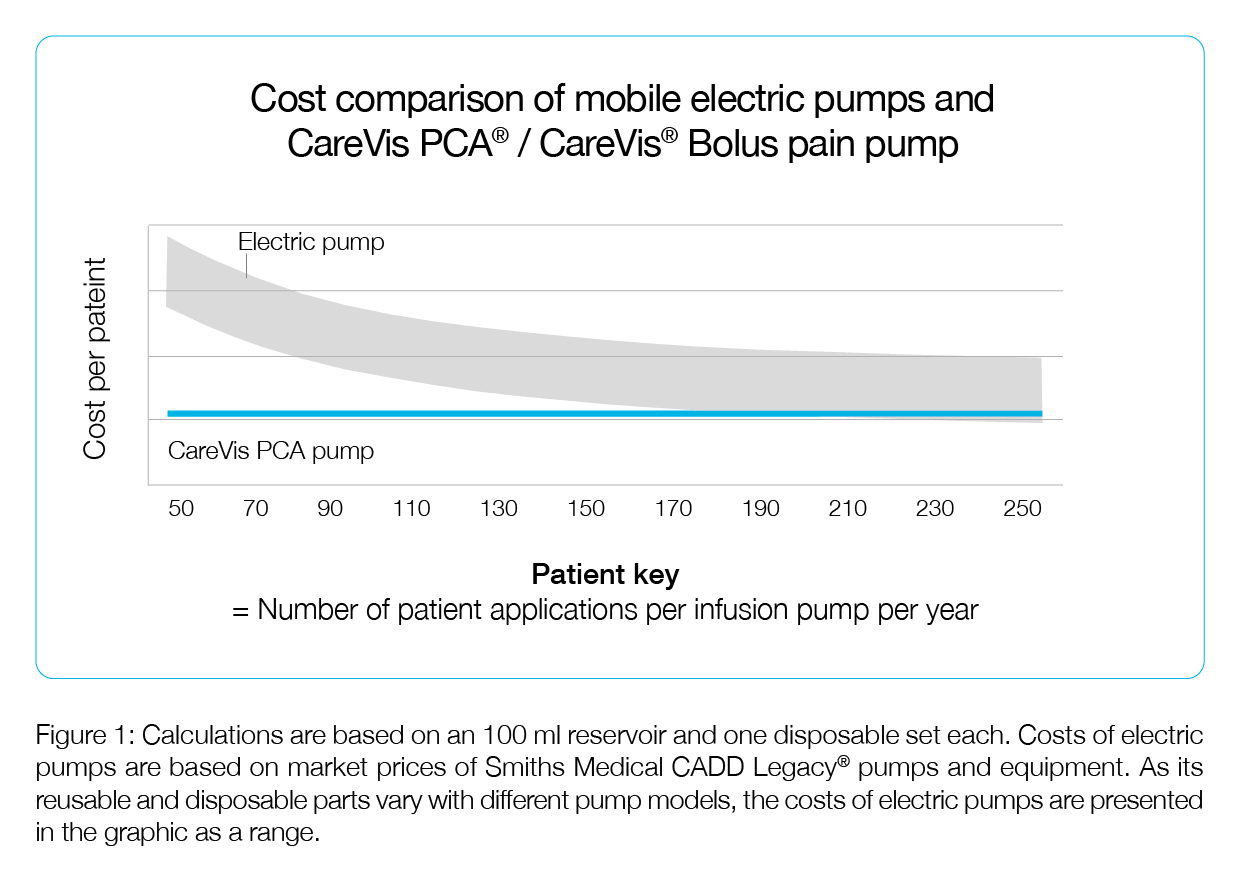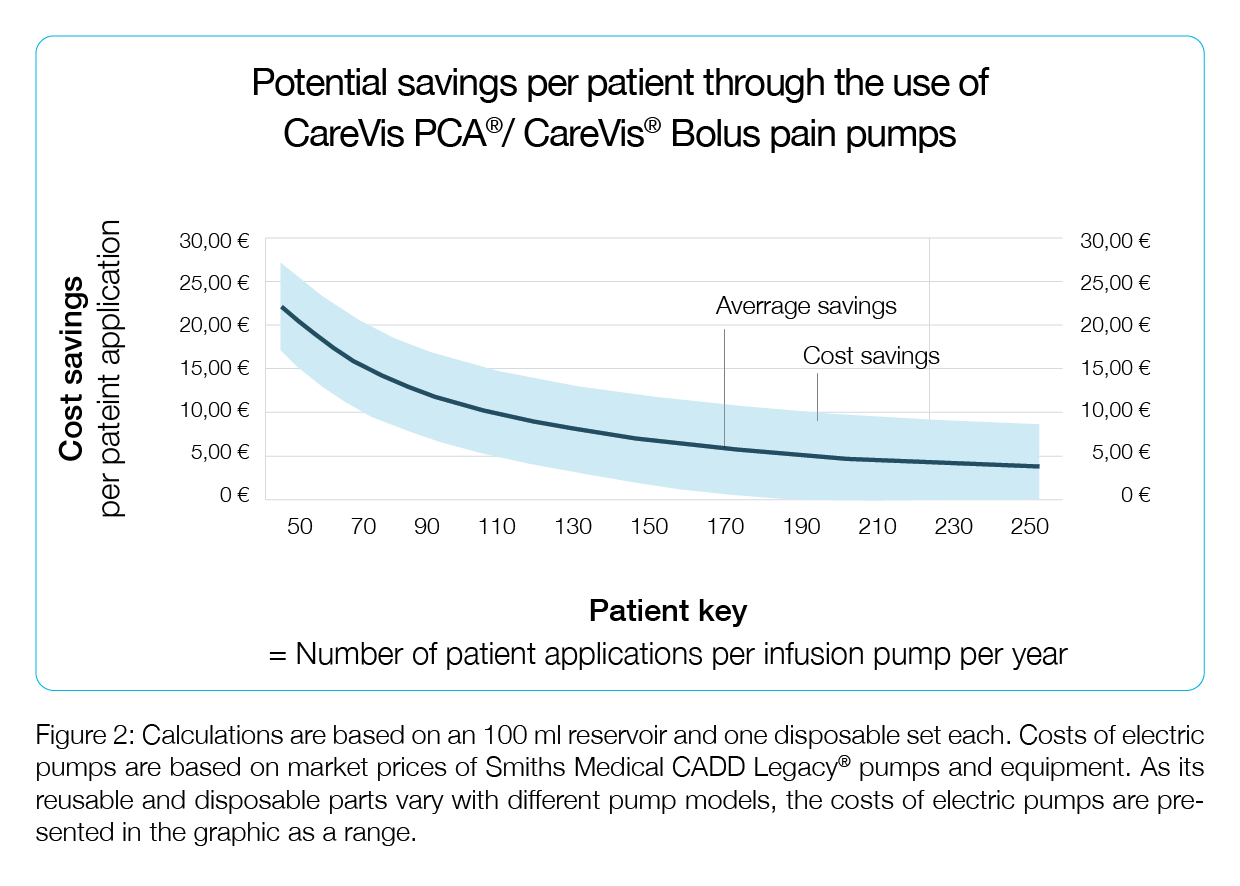Cost comparison between elastomeric pumps and electric infusion pumps. Elastomeric PCA pumps offer considerable cost saving potential in postoperative pain therapy.
Patient-controlled analgesia (PCA) allows patients to adjust their pain medication independently through so called pain pumps. Mobile pumps, that function without external power supply enable early mobilisation and reduce postoperative complications. The two most common types of mobile PCA pumps are electric infusion pumps and elastomeric pumps. Elastomeric pumps have been in use for over 30 years [1] and are appreciated for their simplicity and high safety standard by patients and medical personnel [2-4]. In postoperative pain therapy they can be an inexpensive alternative to electric pumps without compromising quality or functionality. Depending on the number of patients treated, these cost savings can be substantial.
PCA pumps commonly used for postoperative pain management:
Mobile electric infusion pumps
Mobile electric infusion pumpsMobile electric infusion pumps, also called ambulatory infusion pumps are battery powered pain pumps. They are equipped with a bolus button for the patient offering a programmable bolus in addition to an optional and also programmable basal flow-rate. Available disposable reservoirs sizes for such pumps are typically 50 – 250 ml. Beside the disposable sterile reservoir (usually a bag or cassette) a disposable administration set and an extension line is necessary
Mobile elastomeric infusion pumps
Elastomeric pumps are mechanical single-use infusion pumps, that run without electricity. They may also be pre-equipped with a bolus function for the patient and an optional fixed basal flow. In addition, multi-rate models with a detachable adjustment key to set the basal flow-rate, optionally with an additional bolus function for the patient, are available. They offer reservoir volumes between 50 and 650 ml.
Types of pain pumps
Patient-controlled analgesia (PCA) has become an integral part of postoperative pain therapy. The use of PCA pumps enables patients to apply pain medication independently and according to their needs, without the presence of a doctor or nursing staff.Mobile and portable PCA pumps allow early postoperative mobilisation, and thereby reduce the risk of complications such as thrombosis or pneumonia. These pain pumps can be used for the application of analgesics in systemic pain therapy or local anaesthetics in continuous regional anaesthesia such as epidural and plexus nerve blocks or wound infiltration.
Factors influencing the selection of the right PCA pump
In addition to the suitability of the PCA pump for the selected therapy, additional factors influence the decision which pump system is economically suitable for the individual clinical environment. Decision making factors (inter alia):
- Duration of treatment per patient
- Number of days of surgery in a clinic
- Presence of an acute pain service (APS)
- Presence of funds for investment
- Cost analysis
Various calculation templates for the cost comparisons of electric versus single-use elastomeric PCA pumps are available [2-8]. The 2014 study of A.-K. Bräscher et al. [8] stands out, as it performs the most detailed and comprehensible cost analysis. The study group compared the costs of single-use elastomeric pumps with a continuous flow rate and mobile electronic pain pumps with bolus function at their clinic (University Hospital Mannheim). Following their calculations, we developed a computational model to compare the costs of CareVis elastomeric pumps to electronic PCA pumps in any hospital setting (surgery days per year, average runtime of PCA pumps, number of electronic pumps currently in use). Our calculations are based on updated market prices of investment and maintenance costs (fixed costs) as well as the costs of consumables/disposables (variable costs) of the respective pump systems. Drug costs (equal for both systems) and personnel costs are not included in the analysis although commented on further down. Fixed costs of electric pumps are high and must be apportioned between all patients treated with these pumps. Therefore, operating costs of electric pumps vary greatly with the number of patients treated. This ratio is called patient key. In Bräscher et al.’s analysis [8], for example, 1000 surgeries were performed in a year with seven mobile electric pumps in operation, resulting in a patient key of 143 (given an 80% availability* of the pump). We estimate, that with a one-day use and 250 days of surgeries per year, one electric pump can theoretically be used for 250 applications per year; but more realistically for 200 applications per year, given an 80% availability* of the pump. If the pump is used over two days after each surgery, the patient key per pump drops from 200 to 100.
Cost-saving potential by using CareVis in post-operative pain therapy
With the high-quality, but inexpensive CareVis elastomeric pumps the costs per patient can be reduced considerably compared to mobile electric PCA pumps. Postoperative pain therapy with electric pumps involves high acquisition costs and regular maintenance costs. These expenses are then apportioned between all patients treated with these pumps. The fewer patients are treated (the lower the patient key) the higher the costs per patient.In postoperative pain therapy with single-use elastomeric pumps the cost per patient stays the same regardless of the patient key. Figure 1 demonstrates the costs of electric pumps andCareVis pumps each with a bolus function and optional basal rate in relation to the patient key.

The amount of potential savings depends on the patient key, which depends primarily on the number of surgery days as well as on the duration of the treatment. (Example: with four days of surgery per week, an average treatment of two days, and an 80% availability* of pump, the patient key is approx. 80). Figure 2 demonstrates the potential costs savings per patient in relation to the patient key. The data are sourced from price levels valid for larger hospitals in Germany. Real-life calculations for single specific hospitals can be offered when individual costs are provided.

Further considerations
Reduced costs in multi-day treatment: Special indications like continuous nerve (plexus) blocks or wound infiltration in surgical areas typically run over three days. In this case, larger volume elastomeric pumps can be used while electric pumps may need more than one disposable administration set, including reservoir and extension lines. The higher cost of a larger elastomeric PCA pump is fully compensated when compared with the costs for multiple disposable administration sets needed in case of electric pumps. The offset between the curves remains. Furthermore, to the disadvantage of electric pumps, the patient key is reduced by the three-day infusion. Reduced personnel costs: The easy and fool-proof operation of elastomeric PCA pumps can reduce personnel costs. Traditionally, hospitals employ a 24-hour acute pain service to operate electric pumps. Elastomeric pumps are much easier to operate and tend to be less reliant on acute pain service personnel. Hospitals using elastomeric pumps as the backbone of their postoperative pain management, typically only need daylight pain service. This may vary from hospital to hospital and depend on the size of hospital. Savings in personnel costs are not considered in the above calculations, but should be weighed up in the decision about pain pump systems. Reduced infection risk: As elastomeric pumps can run continuously for multiple days and consist of a closed system from the reservoir to the patient connector, the risk of contamination by opening and closing lines is greatly reduced. This is especially important in intra tissue infusions, such as wound infiltration or epidural and plexus nerve. It is a non-economical side effect in favour of elastomeric pumps.
Conclusion
The analysis shows a clear cost advantage of elastomeric pumps over electric pumps in postoperative pain therapy. Elastomeric pumps are reliable, easy to use and do not involve high investment and maintenance costs. In addition, they do not rely on 24-hour acute pain service. Thus, there is considerable potential for cost savings with single-use elastomeric pumps, especially in smaller hospitals where surgeries are less frequent. If you would like us to calculate your individual cost savings, please contact us.
Download
Cost comparison infusion pumps
Literature
- Zahnd, D., et al., A randomized crossover trial assessing patient preference for two different types of portable infusion-pump devices. Ann Oncol, 1999. 10(6): p. 727-9.
- Sawaki, Y., R.K. Parker, and P.F. White, Patient and nurse evaluation of patient-controlled analgesia delivery systems for postoperative pain management. J Pain Symptom Manage, 1992. 7(8): p. 443-53.
- Skryabina, E.A. and T.S. Dunn, Disposable infusion pumps. Am J Health Syst Pharm, 2006. 63(13): p. 1260-8.
- Capdevila, X., et al., Patient-controlled perineural analgesia after ambulatory orthopedic surgery: a comparison of electronic versus elastomeric pumps. Anesth Analg, 2003. 96(2): p. 414-7, table of contents.
- Banks, S. and T. Pavy, A portable, disposable device for patient-controlled epidural analgesia following Caesarean section: evaluation by patients and nurses. Aust N Z J Obstet Gynaecol, 2001. 41(4): p. 372-5.
- Hardy, E.M., C. Williamson, and G.J. Sewell, An evaluation of six infusion devices for the continuous infusion of cytotoxic drugs in ambulatory patients. Journal of Oncology Pharmacy Practice, 1995. 1(1): p. 15-22.
- Lowry, F., Targeting Drug Wastage Slashes Chemotherapy Cost. . Hem Onc Pharmacy Focus 2010. 37
- Bräscher, A.K., et al., Kostenminimierungsanalyse in der postoperativen Schmerztherapie. Der Anaesthesist, 2014. 63(10): p. 783-792.
